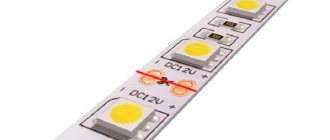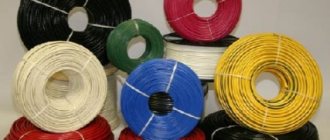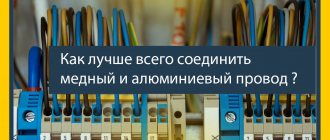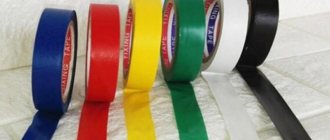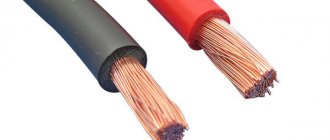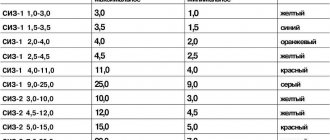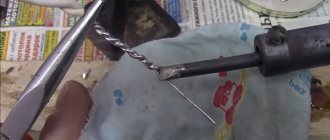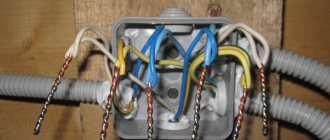It would seem that what could be simpler than connecting wires? After all, there are several ways to connect wires. This includes twisting wires, soldering wires, welding wires, crimping and connecting wires using a terminal block. Even a schoolchild knows the easiest way to twist conductors. You need to put the ends of the metal wires, called strands, together and twist them into one “pigtail”, and then wrap them with electrical tape. There is no need for a soldering iron, terminal block, connecting caps and other “unnecessaries”. Any “own electrician” has mastered this operation. And, when the need arises, he applies this method in his daily practice. For example, it splices the power cord wires of a household appliance, tablet or computer adapter after a break. Russian “technicians” use this technology for fastening wires everywhere. It’s just that the rules for the design of electrical installations of PES do not provide for “twisting”, all kinds of “bends” and “rivets”. There are no such electrical installation methods in other regulatory documents. Why?
A quick connection with big consequences
We often don’t think about the consequences of such a “simplification”. Meanwhile, an unreliable contact will fail at the most inopportune moment; the power supply to consumers/power receivers can always be cut off. Voltage “surges” cause breakdown of the elements of the power cascades of complex SBT household appliances. Even special protection devices used in the most “sophisticated” models of foreign manufacturers cannot save you from breakdown.
The induction of short electromagnetic pulses with a voltage of several thousand volts onto the electronic filling causes “harmless” sparking at the joints. At the same time, the standard protection equipment with which apartments are now equipped (RCDs, circuit breakers, fuses) do not “see” such short low-current pulses, so they simply do not trigger them, and we do not accept installing special devices for this. Uninterruptible power supplies for computers also did not become a panacea for transient impulses. The occurrence of “poke” causes malfunctions in the operation of electronic equipment and computer equipment, leading to failure of electrical components and expensive functional modules. Overheating at the site of a poor connection leads to even more catastrophic consequences; when current passes, the weakened connecting node becomes red-hot. This often causes fires and fires, causing enormous damage to the owners of the premises. Statistics show that 90% of all electrical wiring faults occur due to twists and poor contact connections of conductors. In turn, the very malfunction of electrical wiring and equipment, according to the Ministry of Emergency Situations, is the cause of one third of the fires that occur in Russia.
However, it so happened historically that several decades ago, in conditions of a shortage of electrical accessories/copper conductors, twisting aluminum wires was considered the main method used in electrical installation work. Twisting as a connection can be used in electrical engineering when carrying out repair and restoration work.
Soldering
It should be noted right away that this operation requires certain knowledge and experience. As paradoxical as it sounds, high-quality twisting is better than bad soldering, remember this.
The soldering process begins with preliminary cleaning of the ends of the wires from insulation and oxides. Then they are twisted, coated with a special substance - flux, and then soldered. You can solder not only copper wires, but also aluminum wires; the main thing is to choose the right flux and solder. The use of active acid flux is not recommended, as it will certainly remain on the wires, as a result of which the connection will quickly collapse.
Soldering alone takes a lot of time, but if everything is done correctly, such a connection will be reliable and durable. After the wires have cooled, they must be carefully insulated.
How to connect wires correctly
How to connect the wires: we start by removing the insulation. Correct connection of conductors must satisfy three basic requirements:
- Ensure reliable contact with a minimum transition resistance between each other, close to the resistance of a single piece of wire.
- Maintain tensile strength, fracture resistance and vibration resistance.
- Connect only homogeneous metals (copper to copper, aluminum to aluminum).
There are several connection methods that satisfy these requirements. Depending on the requirements for electrical wiring and the possibilities of practical application, the following types of wire connections are used:
- Twisting.
- Welding.
- Spike.
- Crimping
- Terminal connection.
All these methods require preliminary preparation of the wire or cable - stripping the insulation to expose the connected cores. Traditionally, rubber, polystyrene, and fluoroplastic are used as insulating shell materials. Additionally, polyethylene, silk and varnish serve as insulation inside. Depending on the structure of the conductive part, the wire can be single-core or multi-core. By single-core is meant a wire whose cross-section is formed by an insulating sheath with a metal core or wiring inside.
In a stranded wire, the metal core is formed by several thin wires. They are usually intertwined and represent a lay, surrounded on the outside by an insulator. Often, individual wires are coated with polyurethane varnish, and nylon threads are added to the structure between them to increase the strength of the wire. These materials, like the fabric braid on the outside, complicate the process of removing the insulation.
Depending on the type of connection, 0.2–5.0 cm of insulation is removed from each end of the wire. Several types of tools are used for this. Using a 5-point system, you can evaluate the quality of insulation removal and the degree of protection against cutting - damage to cores by each device:
Damage to insulation/core
Fitter's (kitchen) knife - 3/3 Side cutters (nippers) - 4/3 Stripper - 5/4 Soldering iron or electric loop burner - 4/4
In low-current television/computer networks, coaxial cables are used. During the cutting process, it is important to carefully cut and remove the insulating jacket without damaging the shielding braid. To access the central vein, it is fluffed up and removed, exposing the trunk. After which the polyethylene insulation is cut with a knife or a special device, the trim is removed from the core. The bifilar in the screen consists of a pair of wires in the screen, which, in order to access the conductors, is also pre-fluffed into wires, allowing access to each core.
Important! To remove the insulating material of an enameled wire with a cross-section of less than 0.2 mm², a soldering iron should be used. The enamel is carefully removed using sandpaper and moving the paper along the wires.
Welding technology
Welding work must be carried out using a protective mask, glasses, gloves, and special clothing. There is a possibility of getting burned by hot metal and “catching bunnies.”
Welding of copper wires at home with an inverter is carried out using graphite and carbon electrodes. You can replace the electrodes with the carbon rod of a used battery.
The copper used in the manufacture of electrical wires is of different composition and quality, which determines the welding mode used. Indicators of the optimally selected mode: the electrode does not stick to the welded area, the arc is stable. This combination can be maintained if you have experience in welding.
- The insulating sheath of the copper cable is removed (7-10 cm);
- Stranded wires are twisted;
- The twisted copper wires are trimmed to form an even cut. The remaining twist length is 5 cm;
- A copper clamping mechanism for removing excess heat is placed on the twist, and grounding (“ground”) is connected;
- The twist section is brought to the electrode;
- Welding work is carried out until a molten copper ball appears at the end of the wires, 1-2 seconds is enough;
- After welding of the copper strands stops so that the insulating material remains intact;
- The cooled ends of the wiring must be insulated (insulating tape, heat-shrink tubing).
Welding copper wires with an inverter using carbon and graphite electrodes
The ease of operation of the do-it-yourself electric arc spot welding machine has made it the most widespread. Main parameters of this equipment:
Expert opinion
It-Technology, Electrical power and electronics specialist
Ask questions to the “Specialist for modernization of energy generation systems”
Welding copper wires: features of the work R rutile rutile, organic, mineral components provide a small percentage of metal spattering, gas protection. Ask, I'm in touch!
How to twist wires correctly
Most often, twisting is used in the repair of electrical wiring, cords and adapters (including low-current) household appliances and equipment. If we are talking about the home electrical network, then the standards provide for the use in homes of wires with a current-carrying core cross-section of 1.5–2.0 mm made of copper and 2.5–4.0 mm made of aluminum. Typically, wires of the VVG and PV brands in a polyvinyl chloride sheath are used for wiring. Power cords of the ShVL and ShTB brands with rubber or PVC insulation have a cross-section of 0.5 - 0.75 mm. You can splice the wires together step by step as follows:
- Degrease the bare ends of the wires by wiping with acetone/alcohol.
- We remove the varnish layer or oxide film by sanding the conductors with sandpaper.
- Apply the ends so that they intersect. We wind clockwise at least 5 turns of one core onto another. To make the twist tight, use pliers.
- We insulate the open current-carrying parts of the wires using electrical tape, or screw on an insulating cap. They should extend beyond the insulation for 1.5–2.0 s to cover the exposed areas of the conductors.
To splice a stranded stripped wire with a single-core wire, another winding technique is used:
- A single wire is wrapped with a stranded wire, leaving the end free without winding.
- The end of the single-core wire is bent 180° so that it presses the twist, then pressed with pliers.
- The connection point must be firmly fixed with electrical tape. For best performance, an insulated heat pipe should be used. To do this, a piece of cambric of the required length is pulled over the connection. To make it grip the wiring more tightly, the tube should be heated, for example, with a hair dryer or lighter.
With a bandage connection, the free ends are placed next to each other and wrapped on top with an existing piece of wire (bandage) made of a homogeneous material. Coupling with a groove provides that before mutual twisting, small hooks are configured from the ends of the wire, they are interconnected, then the edges are wrapped. There are more complex varieties of parallel/serial connections. Connecting wires using the twisting method is used by professional electrical repairmen when carrying out restoration work.
Important! Copper and aluminum have different ohmic resistances; when they interact, they actively oxidize; due to different hardnesses, the connection turns out to be fragile, so the connection of these metals is undesirable. In case of emergency, the ends to be connected should be prepared - tinned with tin-lead solder (PLS) using a soldering iron.
Welding aluminum wires
Before welding, you need to strip the wires of 50 - 70 mm of insulation and 20 -30 mm of oxide film and twist them. The end plane must be smooth and clean. Twisting is carried out before the actual welding. Point contact during work falls on it. This applies to all types of wires.
Expert opinion
It-Technology, Electrical power and electronics specialist
Ask questions to the “Specialist for modernization of energy generation systems”
Protective means Copper is a specific type of metal whose welding is carried out only in a well-protected environment that prevents the interaction of carbon and surrounding air. Ask, I'm in touch!
Why is it better to crimp (crimp) wires?
Wire crimping is one of the most reliable and high-quality methods of mechanical connections currently used. With this technology, loops of wires and cables are crimped into a connecting sleeve using press pliers, ensuring tight contact along the entire length.
The sleeve is a hollow tube and can be made independently. For liner sizes up to 120 mm², mechanical pliers are used. For large sections, products with a hydraulic punch are used.
When compressed, the sleeve usually takes the shape of a hexagon; sometimes local indentation is made in certain parts of the tube. In crimping, sleeves made of electrical copper GM and aluminum tubes GA are used. This method allows for crimping conductors made of different metals. This is largely facilitated by the treatment of the constituent components with quartz-vaseline lubricant, which prevents subsequent oxidation. For joint use, there are combined aluminum-copper sleeves or tinned copper sleeves GAM and GML. Wire connections using the crimp method are used for conductor bundles with a total cross-sectional diameter between 10 mm² and 3 cm².
Crimping
This method is a process of connecting wires by crimping them with a special tubular sleeve or tip. These devices are used if the cross-section of the copper wire is 2.5-240 square meters. mm. The undeniable advantages of crimping technology are the speed and accuracy of the work, as well as the subsequent durability and safety of the connections.
For crimping, a special tool is used - mechanical, hydraulic or electric pliers or professional crimping presses. The selection of sleeves is carried out taking into account the cross-section and number of connected wires.
After removing the insulation and stripping the cores, quartz-vaseline paste is applied to them, a sleeve is put on and crimped. The pressed sleeves are insulated.
Soldering as a reliable alternative to twisting
The closest alternative to twisting, which is prohibited for electrical installation, is to connect wires using the soldering method. It requires special tools and consumables, but provides absolute electrical contact.
Advice! Overlapping wire soldering is considered the most unreliable in technology. During operation, the solder crumbles and the connection opens. Therefore, before soldering, apply a bandage, wrap a piece of wire of a smaller diameter around the parts being connected, or twist the conductors together.
You will need an electric soldering iron with a power of 60–100 W, a stand and tweezers (pliers). The soldering iron tip should be cleaned of scale, sharpened, having first selected the most suitable shape of the tip in the form of a spatula, and the body of the device should be connected to the ground wire. Among the “consumables” you will need POS-40, POS-60 solder from tin and lead, rosin as a flux. You can use solder wire with rosin placed inside the structure.
If you need to solder steel, brass or aluminum, you will need a special soldering acid.
Important! Do not overheat the junction points. To prevent the insulation from melting when soldering, be sure to use a heat sink. To do this, hold the bare wire between the heating point and the insulation with tweezers or needle-nose pliers.
- The wires stripped of insulation should be tinned, for which the tips heated with a soldering iron are placed in a piece of rosin; they should be covered with a brown-transparent layer of flux.
- We place the tip of the soldering iron tip into the solder, grab a drop of molten solder and evenly process the wires one by one, turning and moving along the tip blade.
- Attach or twist the wires together, securing them motionless. Warm up with the tip for 2–5 s. Treat the areas to be soldered with a layer of solder, allowing the drop to spread over the surfaces. Turn over the wires to be connected and repeat the operation on the reverse side.
- After cooling, the soldering joints are insulated in the same way as twisting. In some compounds, they are pre-treated with a brush dipped in alcohol and coated with varnish.
Advice! During and after soldering for 5–8 s. The wires cannot be pulled or moved, they must be in a stationary position. A signal that the structure has hardened is when the solder surface acquires a matte tint (it shines in the molten state).
Soldering VS welding
To ensure good contact, soldering or welding of copper wires is most often used. Which of these methods is better? Definitely welding. The fact is that soldering is a rather labor-intensive and time-consuming process, especially if you need to connect a multi-core copper cable. Plus, soldered joints are destroyed over time due to the presence of a third, looser and fusible metal - solder. The presence of transition resistance at the junctions of different alloys contributes to the occurrence of destructive chemical reactions and other negative processes.
When copper wire is welded, the concept of “contact” disappears altogether, since the connection is made monolithic from the same type of metal. Naturally, such connections are characterized by record low resistance, due to which virtually no heat is generated.
But welding is still preferable
In terms of connection strength and contact quality, welding surpasses all other technologies. Recently, portable welding inverters have appeared that can be transported to the most inaccessible places. Such devices are easily held on the welder's shoulder using a belt. This allows you to work in hard-to-reach places, for example, welding from a stepladder in a distribution box. To weld metal cores, carbon pencils or copper-plated electrodes are inserted into the holder of the welding machine.
The main disadvantage of welding technology - overheating of the parts being welded and melting of the insulation - is eliminated using:
- Correct adjustment of the welding current 70–120 A without overheating (depending on the number of welded wires with a cross-section from 1.5 to 2.0 mm).
- The duration of the welding process is no more than 1–2 seconds.
- Tightly pre-twist the wires and install a copper heat sink clamp.
When connecting wires by welding, the twisted wires should be bent and the cut side must be turned upward. An electrode is brought to the end of the wires connected to ground and the electric arc is ignited. The molten copper flows down in a ball and covers the twisted wire with a sheath. During the cooling process, an insulating belt made from a piece of cambric or other insulating material is put on the warm structure. Lacquered fabric is also suitable as an insulating material.
Electrodes for welding wires
The choice of the appropriate type of electrode determines the quality of the work done. It is necessary to select welding tools that optimally meet the parameters of the upcoming process. The general classification of these tools used in the welding process includes electrodes for:
- Alloy steel;
- High-alloy steel with non-standard parameters;
- Metal surfacing (applying a metal alloy or metal to the surface of an object by fusion welding);
- Non-ferrous metals;
- Structural steel;
- Cast iron.
The electrode coating defines the following typology:
- A – acid coating (oxide of iron, silicon, manganese);
- B – basic coating that allows welding with direct current of alternating polarity. Contains calcium carbonate, calcium fluoride;
- C – cellulose spraying creates gas protection during welding (flour, compounds of organic origin);
- R – rutile (rutile, organic, mineral components) provides a low percentage of metal splashing and gas protection.
Terminal blocks are the most ergonomic electrical installation products
The PUE rules, clause 2.1.21 provide for the type of connections using clamps (screws, bolts). There is a connection directly using hanging fasteners, when a screw and washer are threaded through the loops of each wire and secured with a nut on the reverse side.
This installation is wrapped with several turns of electrical tape and is considered quite practical and reliable. Electrical installation products called screw terminal blocks are more ergonomic. They represent a contact group housed in a housing made of insulating material (plastic, porcelain). The most common way to connect wires using terminal blocks is in junction boxes and electrical panels. To connect the wire, you need to insert it into the socket and tighten the screw; the clamping bar will securely fasten the wire to the seat. Another connecting wire is connected to the mating socket, short-circuited with the first one.
In self-clamping terminal blocks of the WAGO type, the wire is snapped into the socket; for better contact, a special paste or gel is used.
Branch clamps are a permanent version of a screw terminal block with several short-circuited taps; they are used mainly outdoors and in places with unfavorable environmental conditions.
The connecting clamps are an insulating cap with a thread inside; it is screwed onto the twist, simultaneously compressing and protecting from mechanical stress.
Crimps and terminal blocks
The use of various crimps and terminal blocks is quite widely practiced when connecting electrical sockets, switches, lighting fixtures, as well as when installing distribution boards. These devices allow you to carefully and quickly connect a single-core copper wire, however, a stranded wire cannot be clamped into a screw clamp without prior soldering or crimping with a tubular tip.
The indisputable advantages of screw terminals include the ability to connect aluminum wires to copper wires, as well as the absence of the need for subsequent insulation of contacts.
However, this type of connection is not without its drawbacks. It requires periodic maintenance, which consists of tightening the clamping elements. Copper is a very soft material, prone to “leakage” under load. Even if connections are made using rigidly spring-loaded self-clamping terminal blocks, due to the too small area of contacting surfaces under heavy loads, the spring elements are heated and released, as a result of which their elasticity decreases along with the quality of the connection.


